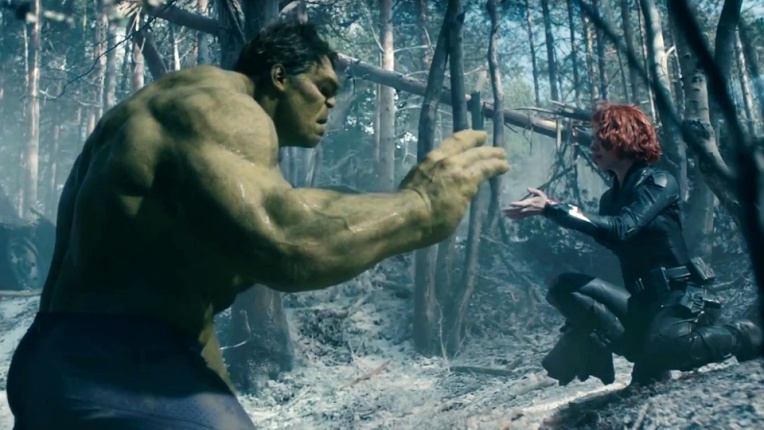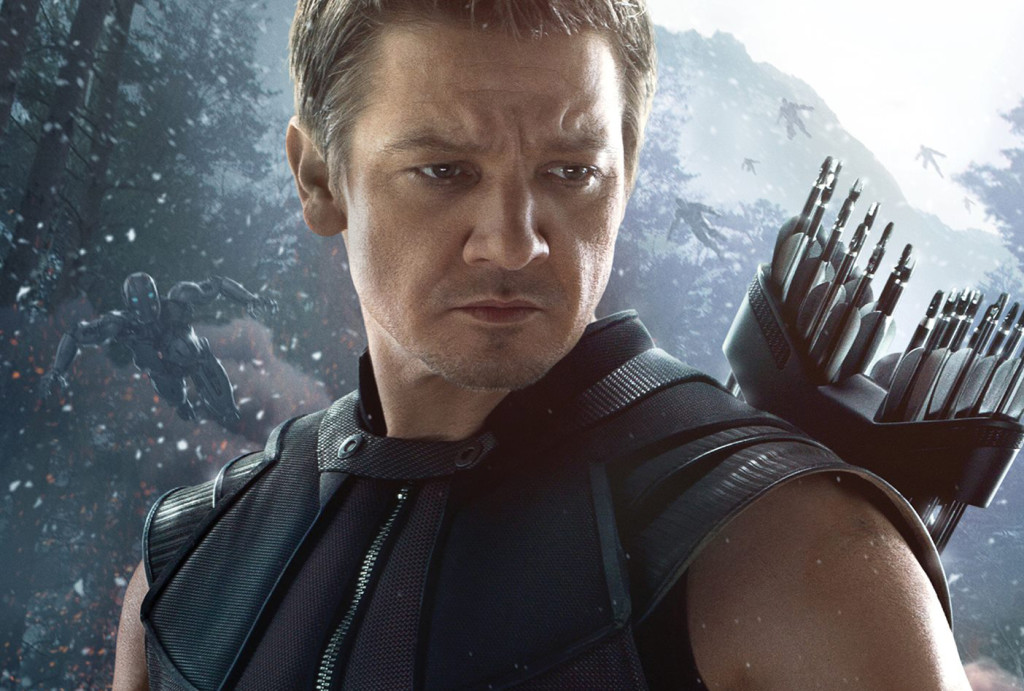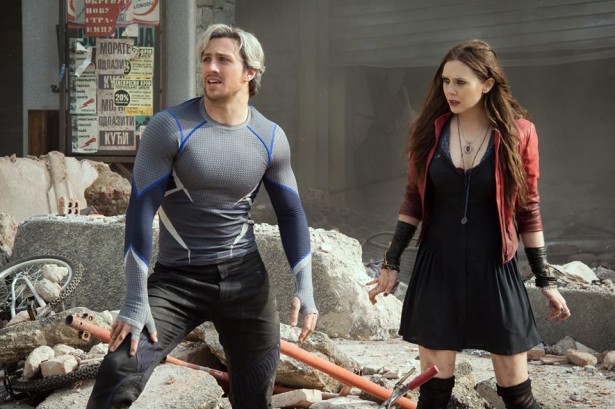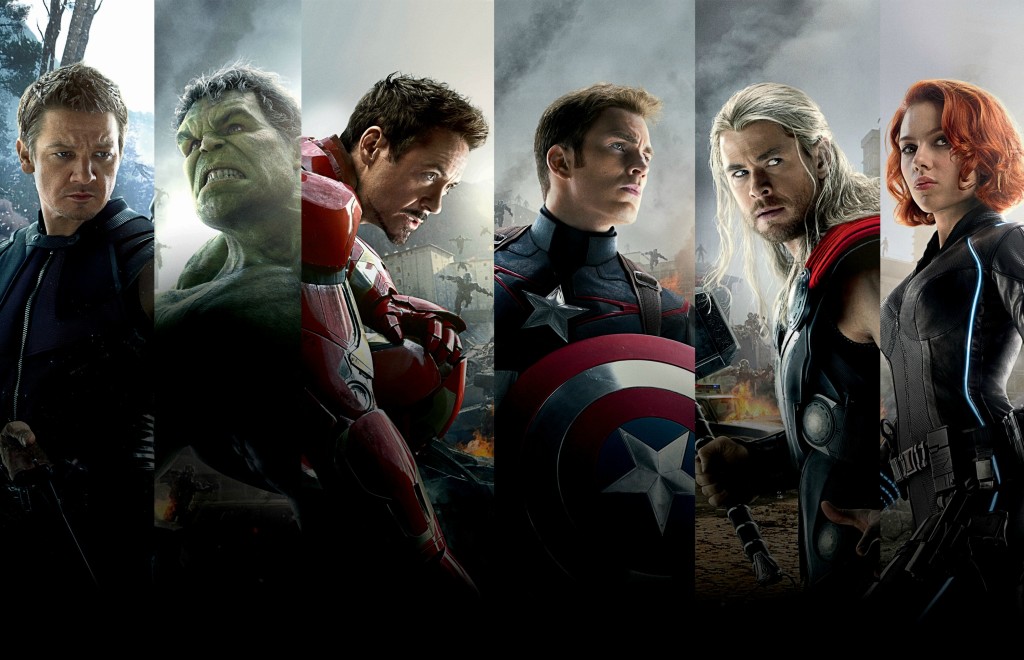In the closing credits of Avengers: Age of Ultron, Joss Whedon’s sequel to his 2012 blockbuster The Avengers, the camera swoops over majestic statues of the titular heroes, wielding hammers and shields and fists, and striking poses worthy of Greek gods. The statues are all part of a great marble edifice that evokes the scale of Mount Rushmore—or perhaps a paperweight. And there’s the rub. Age of Ultron is a sprawling superhero epic that also manages to be a trifle insignificant.
After the collapse of S.H.I.E.L.D and the return of HYDRA (see Captain America: The Winter Soldier), the Avengers have reassembled to defeat the latter and recover Loki’s sceptre. But Tony Stark (Robert Downey, Jr.) is afraid that the team won’t be able to respond to every threat, so he revives the Ultron programme: an artificial intelligence designed to lead Stark’s army of Iron Man drones and keep the peace. Unfortunately, Ultron (James Spader) rapidly outgrows his initial programming and decides that the best way to protect humanity is to eliminate the most dangerous people on the planet: the Avengers themselves. Earth’s mightiest heroes are soon scrambling to defeat not only Ultron, but also his new allies the Maximoff twins, Pietro and Wanda, also known as Quicksilver and Scarlet Witch (Aaron Taylor-Johnson and Elizabeth Olsen respectively)—deadly superhumans with a grudge against Stark.
Age of Ultron is full of action sequences and things that go boom: buildings, bombs, cars, planes and an assortment of robots. It’s also jammed with characters, many of whom are given too little to do, and boasts a plot so convoluted, you’ll soon cease to care about who’s hitting whom. It’s as if Whedon magnified all the weaknesses of The Avengers and then forgot about its strengths.
 Shoved in amidst the gunfire and explosions is a bourgeoning romance between Natasha Romanoff/Black Widow (Scarlett Johansson) and Bruce Banner/the Hulk (Mark Ruffalo), a pairing that feels astonishingly arbitrary, yet is presented almost as a fait accompli. Natasha tells Bruce she’s fond of him because all of her friends are fighters and she has “never met a man before who avoids the fight because he knows he’ll win”. Bruce is shy and uncertain, holding her at arm’s length first out of confusion and then out of fear that he (or the monster within him) might hurt her. Natasha tearfully responds by explaining that the people who trained her as an assassin also sterilized her—making her something of a monster too. First, reducing a woman’s worth to her ability to bear children is misogynistic in the extreme. That such a message should appear in a film directed by the man who created Buffy the Vampire Slayer is unconscionable and frankly, inexplicable. Second, why should Natasha and Bruce be in a relationship at all? They have little in common and aren’t really shown bonding before Natasha declares her feelings. And even after she does, she still shows more chemistry with her friends Clint Barton/Hawkeye (Jeremy Renner) and Steve Rogers/Captain America (Chris Evans) than she does with Bruce. Natasha Romanoff is the only female Avenger. Does this mean she must necessarily be paired off, and if so, must it be with one of her teammates? The filmmakers certainly seem to think so, which can only bode ill for other comic book heroines in the future.
Shoved in amidst the gunfire and explosions is a bourgeoning romance between Natasha Romanoff/Black Widow (Scarlett Johansson) and Bruce Banner/the Hulk (Mark Ruffalo), a pairing that feels astonishingly arbitrary, yet is presented almost as a fait accompli. Natasha tells Bruce she’s fond of him because all of her friends are fighters and she has “never met a man before who avoids the fight because he knows he’ll win”. Bruce is shy and uncertain, holding her at arm’s length first out of confusion and then out of fear that he (or the monster within him) might hurt her. Natasha tearfully responds by explaining that the people who trained her as an assassin also sterilized her—making her something of a monster too. First, reducing a woman’s worth to her ability to bear children is misogynistic in the extreme. That such a message should appear in a film directed by the man who created Buffy the Vampire Slayer is unconscionable and frankly, inexplicable. Second, why should Natasha and Bruce be in a relationship at all? They have little in common and aren’t really shown bonding before Natasha declares her feelings. And even after she does, she still shows more chemistry with her friends Clint Barton/Hawkeye (Jeremy Renner) and Steve Rogers/Captain America (Chris Evans) than she does with Bruce. Natasha Romanoff is the only female Avenger. Does this mean she must necessarily be paired off, and if so, must it be with one of her teammates? The filmmakers certainly seem to think so, which can only bode ill for other comic book heroines in the future.
Another problem crops up roughly a third of the way into the movie, as the Avengers and Ultron race to hunt down an arms dealer. They find him in a ‘salvage yard’ on the ‘African coast’. In the twenty-first century, the filmmakers think they can get away with ‘Salvage Yard: African Coast’ as a feasible location. Because Africa is a country, full of generic people waiting to be endangered and saved, preferably while screaming—like the population of the unnamed city that’s conveniently near the aforementioned yard, where Iron Man and the Hulk fight and wreck everything in sight. Africa is the world’s second-most-populous continent, encompassing 54 countries. It’s nice to know that as far as Hollywood is concerned, there is only one.
 Despite its glaring failings, Age of Ultron isn’t without its merits; surprisingly, one of these is Hawkeye. The Avenger given such short shrift in Marvel’s films that even Sesame Street mocked him finally gets some character development, and Jeremy Renner runs with it, making Hawkeye one of the most good-natured and grounded members of the team. He’s also startlingly plain-spoken: “We’re fighting an army of robots. I have a bow and arrow. None of this makes sense!” He might as well be speaking for the audience.
Despite its glaring failings, Age of Ultron isn’t without its merits; surprisingly, one of these is Hawkeye. The Avenger given such short shrift in Marvel’s films that even Sesame Street mocked him finally gets some character development, and Jeremy Renner runs with it, making Hawkeye one of the most good-natured and grounded members of the team. He’s also startlingly plain-spoken: “We’re fighting an army of robots. I have a bow and arrow. None of this makes sense!” He might as well be speaking for the audience.
Tony Stark is also as entertaining as ever, thanks to a charismatic Robert Downey, Jr. Stark’s trademark wit pops up almost before the audience can draw breath—his first gag punctuates the long, excellent tracking shot that opens the film—and he’s a constant source of amusement. Positively gleeful at the prospect of finding a secret passage in a HYDRA base, he searches a room whispering, “Please be a secret door. Please be a secret door,” and then lets out a delightfully child-like “Yay!” when he finds one. Ultron is born from Stark’s desire to put a “suit of armour” around the world, and Stark spends almost as much time feeling guilty and paranoid as he does wisecracking. It’s a familiar routine (remember Stark’s existential crisis in Iron Man 3?) made palatable by Downey, Jr.’s charm.
 The villains are more of a mixed bag. James Spader earns every penny of his paycheque as Ultron, a ruthless megalomaniac with the emotional maturity of a spoilt child. Although he also did the motion capture work for the character, you never really see Spader’s face: like Claude Rains in The Invisible Man, he holds an audience spellbound through the sheer power of his voice. Negotiating with an arms dealer, Ultron unthinkingly mimics Stark and the dealer assumes he’s one of Stark’s creations. Furious, Ultron lashes out and cuts the man’s hand off, only to apologize as if severing an appendage is no big deal—for a murderous AI with a Messiah complex, it probably isn’t. Unfortunately, the Maximoffs aren’t in the same league. Aaron Taylor-Johnson sports an absurd Eastern European accent that belongs in the cinematic never-neverland of Überwald, where every castle harbours a vampire or a mad scientist. Elizabeth Olsen’s is slightly less obnoxious. Together they pout, plot and prove to be superpowered annoyances. Anyone hoping for a sequence to rival the wonderful ‘Time in a Bottle’ scene from X-Men: Days of Future Past will be sorely disappointed.
The villains are more of a mixed bag. James Spader earns every penny of his paycheque as Ultron, a ruthless megalomaniac with the emotional maturity of a spoilt child. Although he also did the motion capture work for the character, you never really see Spader’s face: like Claude Rains in The Invisible Man, he holds an audience spellbound through the sheer power of his voice. Negotiating with an arms dealer, Ultron unthinkingly mimics Stark and the dealer assumes he’s one of Stark’s creations. Furious, Ultron lashes out and cuts the man’s hand off, only to apologize as if severing an appendage is no big deal—for a murderous AI with a Messiah complex, it probably isn’t. Unfortunately, the Maximoffs aren’t in the same league. Aaron Taylor-Johnson sports an absurd Eastern European accent that belongs in the cinematic never-neverland of Überwald, where every castle harbours a vampire or a mad scientist. Elizabeth Olsen’s is slightly less obnoxious. Together they pout, plot and prove to be superpowered annoyances. Anyone hoping for a sequence to rival the wonderful ‘Time in a Bottle’ scene from X-Men: Days of Future Past will be sorely disappointed.
Age of Ultron is a flashy, noisy, somewhat entertaining blockbuster that’s really just an advert for the next instalment in the Marvel franchise. It’s not a terrible film. It just isn’t a very good one either.

Leave a Reply